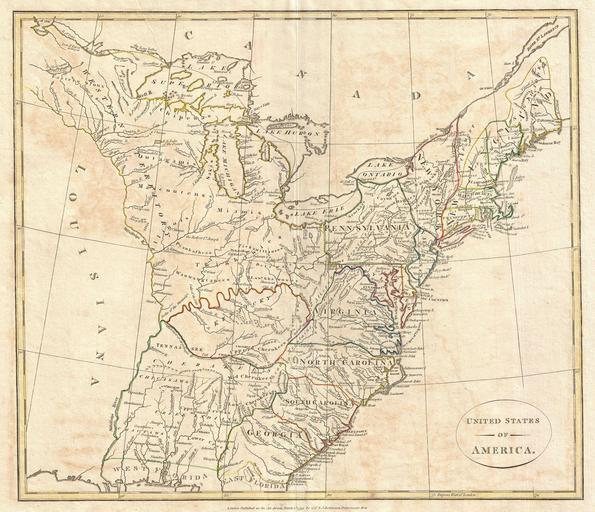MAKE A MEME
View Large Image

| View Original: | 1799_Cruttwell_Map_of_the_United_States_of_America_-_Geographicus_-_UnitedStates-cruttwell-1799.jpg (3500x3011) | |||
| Download: | Original | Medium | Small | Thumb |
| Courtesy of: | commons.wikimedia.org | More Like This | ||
| Keywords: 1799 Cruttwell Map of the United States of America - Geographicus - UnitedStates-cruttwell-1799.jpg This is a highly unusual and extremely scarce 1799 map of the United States by the English map publisher Clement Cruttwell Depicts a post-colonial pre-Louisiana United States extending from the Mississippi River to the Atlantic seaboard and from Florida to Canada Though clearly based on Guthrie's c 1780s map of the same title this map offers a number of important innovations and updates that make this a significant cartographic piece in its own right This map exhibits a combinations of up to date cartographic information and references to mid 18th century colonial charters An excellent example is Pennsylvania's northern border which is drawn extending northward as far as Lake Ontario This rarely seen border configuration references an ambiguity in Pennsylvania's 1681 royal charter The charter suggests that King Charles II intended to grant William Penn three full degrees of north-south latitude about 180 miles This would put Pennsylvania's northern border at roughly 43° parallel as shown here Shortly before this map was drawn the Pennsylvania and New York governments settled on 42° as Pennsylvania's northernmost border Clearly Cruttwell was relying on somewhat outdated information to construct his map Further north another interesting example is the additional territory of Sagahadok occupying much of modern day Maine's northern tier Sagahadok or Sagahadoc is the legacy of an early 17th British effort to colonize North America Technically Sagahadoc refers to the territory between the Kennebec River and Nova Scotia In the few mid 18th centurymaps that actually show Sagahadoc such as Faden's map depicting the United States according to the 1784 Treaty of Paris the region is depicted as a territory attached to the Massachusetts Colony However by this time it has been fully separated from Massachusetts and is drawn as a separate colony The appearance of Sagahadoc may be related to a post Revolutionary War British attempt to add this part of northern Maine to their Nova Scotia Colony referencing an early claim to the territory dating from its original failed 1620 colonization attempt Similarly Vermont through clearly identified in its present location is here added to British controlled Canada In the southwest a fledgling Kentucky appears with a northern border adhering to the Ohio River and a southern border encompassing much of today's Tennessee Though at this time there were many American Indian groups still active in Kentucky including the Upper Cherokee and Tennessee tribe most with the incorporation of the state were relocated south of the Tennessee River This is evident in the large unnamed territory extending as far south as West Florida and occupying much of what is today Mississippi Alabama and Georgia Within this region numerous American Indian nations are identified including the Tennessee Cherokee Creek Choctaw Chickasaw and others Along the Eastern seaboard Georgia South Carolina North Carolina and Virginia appear roughly in their current configuration though are clearly bounded on the west by the Appellation Mountains and in the case of Georgia the Flint River In the south East and West Florida are at this time disputed territories passing back and forth between British and Spanish control The extreme northwest comprising the vast territory north of the Ohio River and west of Pennsylvania including the Great Lakes is identified as the Western Territory As with the unnamed territory to the south of Kentucky this northern region is largely dominated by American Indian tribes including the Sioux Miami Delaware Saks Chippewa and others The Great Lakes themselves are riddled with errors including a number of apocryphal islands dating to Bellin's mid 18th century map of the territory These include Isle Philippeaux Isle Ponchartrain and several additional unnamed islands in Lake Superior 1799 dated Size in 16 14 object history credit line accession number UnitedStates-cruttwell-1799 Cruttwell C <i>Atlas to Cruttwell's Gazetteer</i> 1799 Geographicus-source PD-Art-100 Maps by Clement Cruttwell 1799 maps Old maps of the United States | ||||